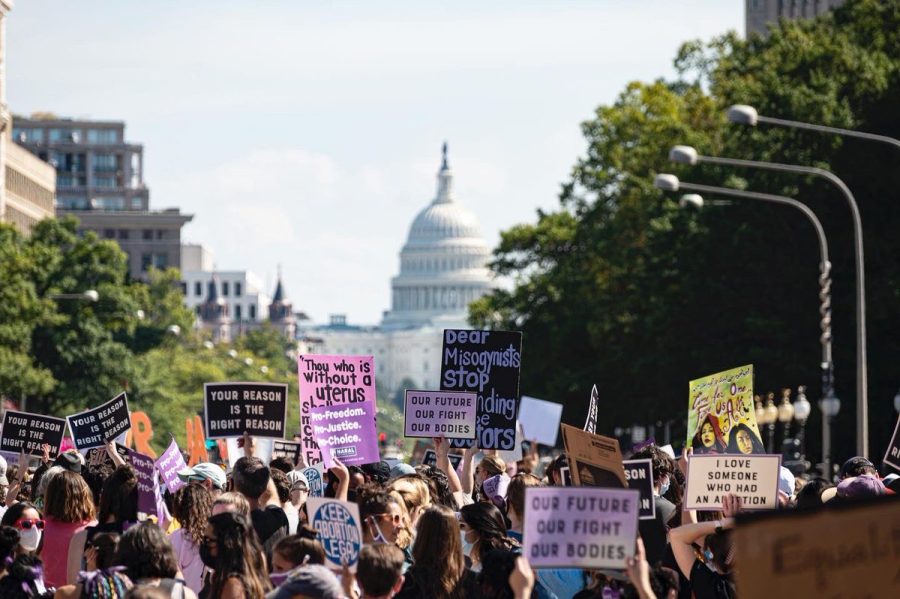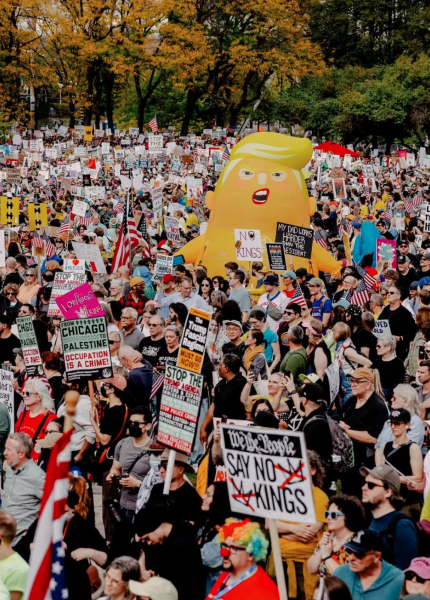Recent Women’s Rights Protests Expose Lack of Unity
I had been milling around Washington Square Park for two and a half hours before the rest of the protestors finally arrived. When they first entered the park, I was met by a stampede of people holding neon poster boards with catchy bon mots. The air was charged, and every internal gripe I had about the heat and why the protest took so long to start was forgotten. It felt like something monumental was happening. Something historical. Something that could change the world.
But once the square was flooded with passionate demonstrators and they all nestled into their individual corners, the urgency of the moment evaporated into the early autumn air.
The protests on Oct. 2 against Texas’s dystopian anti-abortion bill had the makings to be a sequel to the Women’s March of 2017, but ultimately fell short.
People were angry four years ago, all unified against the same issue. Millions of people protested globally, pink hats dominating the news and rippling through cities all over the world.
I thought the same thing would happen on Oct. 2. People were, and still are, angry, and were once again united against a common enemy: Senate Bill 8. This new Texan bill is the latest frightening threat to reproductive rights and Roe v. Wade, the 1973 Supreme Court case that legalized abortion in the U.S.
Not only does this new law ban abortion after the six-week mark, which is typically before most people even know they’re pregnant, it makes no exception for rape or incest. Most alarmingly, the new law deputizes private citizens. It gives individuals the right to sue abortion doctors, people seeking abortions and those helping them if they perform or want an abortion past the alloted six weeks. If they win their civil suits, these “anti-abortion bounty hunters” could collect at least $10,000 in damages.
People are angry about this law and they are afraid of what our country will look like under it. But the march on Oct. 2 did not unify all these angry, afraid people in one strong, empowering and effective protest. Instead, on the day of the protest there were conflicting messages about when and where to meet, the route of the protest, who would be speaking and which groups were marching.
When the mass of protestors finally arrived in Washington Square Park, hours later than anticipated, the fading momentum was recharged, only to quickly be lost again when other groups arrived, screaming separate chants through their megaphones. It quickly became clear that although this movement had a common enemy, the movement itself was not unified. It felt like being in high school, with different cliques vying for popularity when they all really want the same thing at their cores.
Despite the confusion, the Oct. 2 protest against Senate Bill 8 amassed thousands of people. While that draw is impressive, it is nowhere near the millions seen at the 2017 Women’s March.
Lower attendance rates are not unique to this march though. Other organizations have recently seen lower turnout too, such as Greta Thunberg’s Fridays For Future campaign. So, if nothing else, the Women’s March is not alone.
The disconnectedness and disappointment of the Oct. 2 protest can lead some to doubt the effectiveness of protests. But Atlantic contributor and UNC professor Zeynep Tufekci believes that protests are successful, it just takes some time before that success is evident.
“Protests sometimes look like failures in the short term, but much of the power of protests is in their long-term effects, on both the protesters themselves and the rest of society,” explains Tufecki.
This waiting period is enormously frustrating considering the dire ramifications that SB 8 will have on people, especially people of color, who are consistently more likely to be failed by the healthcare system compared to white people.
In order to be conscious of this racial disparity, Women’s March organizers say that protestors should not attend sporting any iconography related to “The Handmaid’s Tale,” a recent trend seen at women’s rights protests. They explain that imagery from the book or TV series implies that Gilead is a dystopia, when in reality, “Black women, undocumented women, incarcerated women, poor women and disabled women have always had their reproducti[ve] freedom controlled in this country.”
Protestors are also being discouraged from bringing coat hangers. Prior to legal abortion, coat hangers were often used in abortion procedures. The use of these hangers to produce abortions is often unsanitary and incredibly dangerous. Now, they are symbols of the dangers and oppression that people face when abortion is illegal. Women’s March organziers have banned coat hanger iconography to prevent “accidentally [reinforcing] the right wing talking points that self-managed abortions are dangerous, scary and harmful.”
When it comes to the banning of coat hangers as imagery at protests, I disagree. Coat hangers are a visceral, painful symbol of how far we have come as a society. While an uncomfortable topic, it reminds us of the gravity of the situation and the severity of the consequences of letting SB 8 go unchallenged. Sometimes, it is necessary to broach uncomfortable topics in order to produce change.
As Ms. Magazine declared in 1973, and so many posters echoed in 2021, “never again.” People will never again return to a time when they were denied reproductive rights without a fight. People will never again face life-threatening circumstances if they dare to take control of their own bodies.
Gloria Steinem, the iconic women’s rights activist and co-founder of the magazine Ms., said, “when unique voices are united in a common cause, they make history.” Right now we’re united against SB 8; we just need to unite our activism and advocacy efforts, too.
Nicole Braun, FCRH ‘24, is undecided from Saddle River, N.J.

Nicole Braun is a senior from Saddle River, N.J. and she is thrilled to be a member of Volume 105! Her love for writing and editing led her to begin writing...








































































































































































































